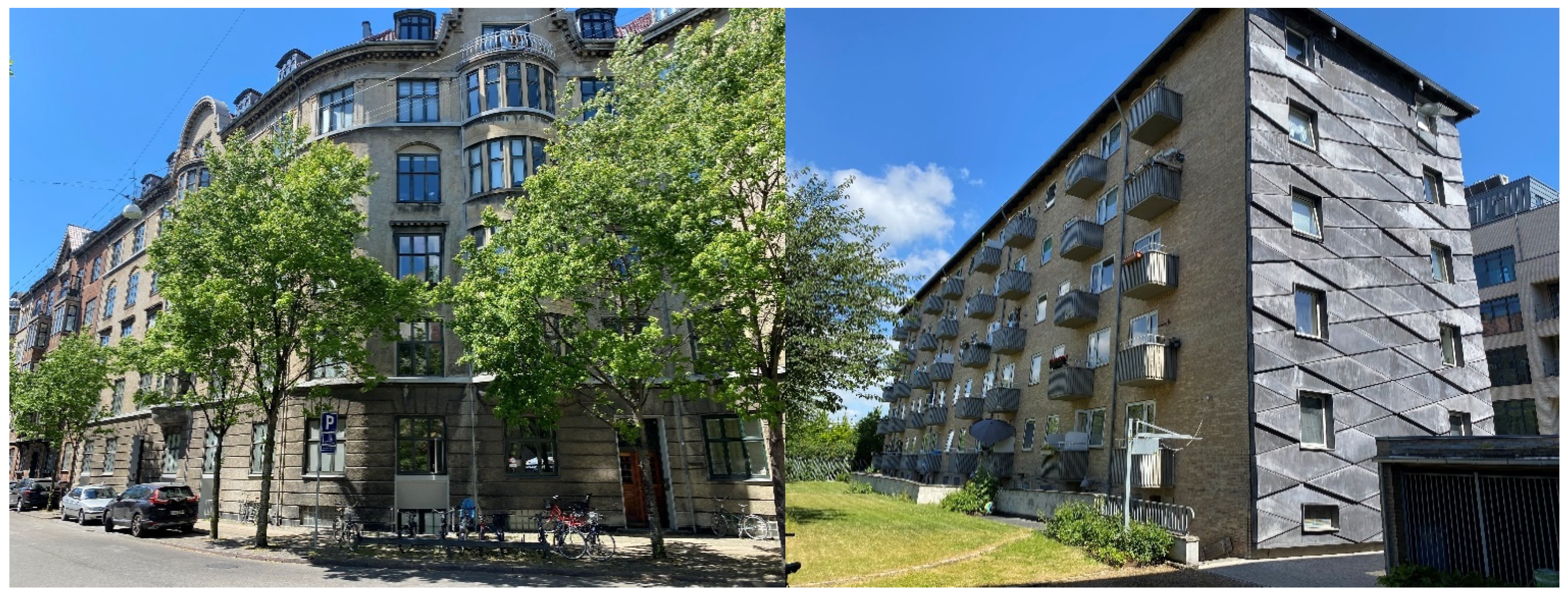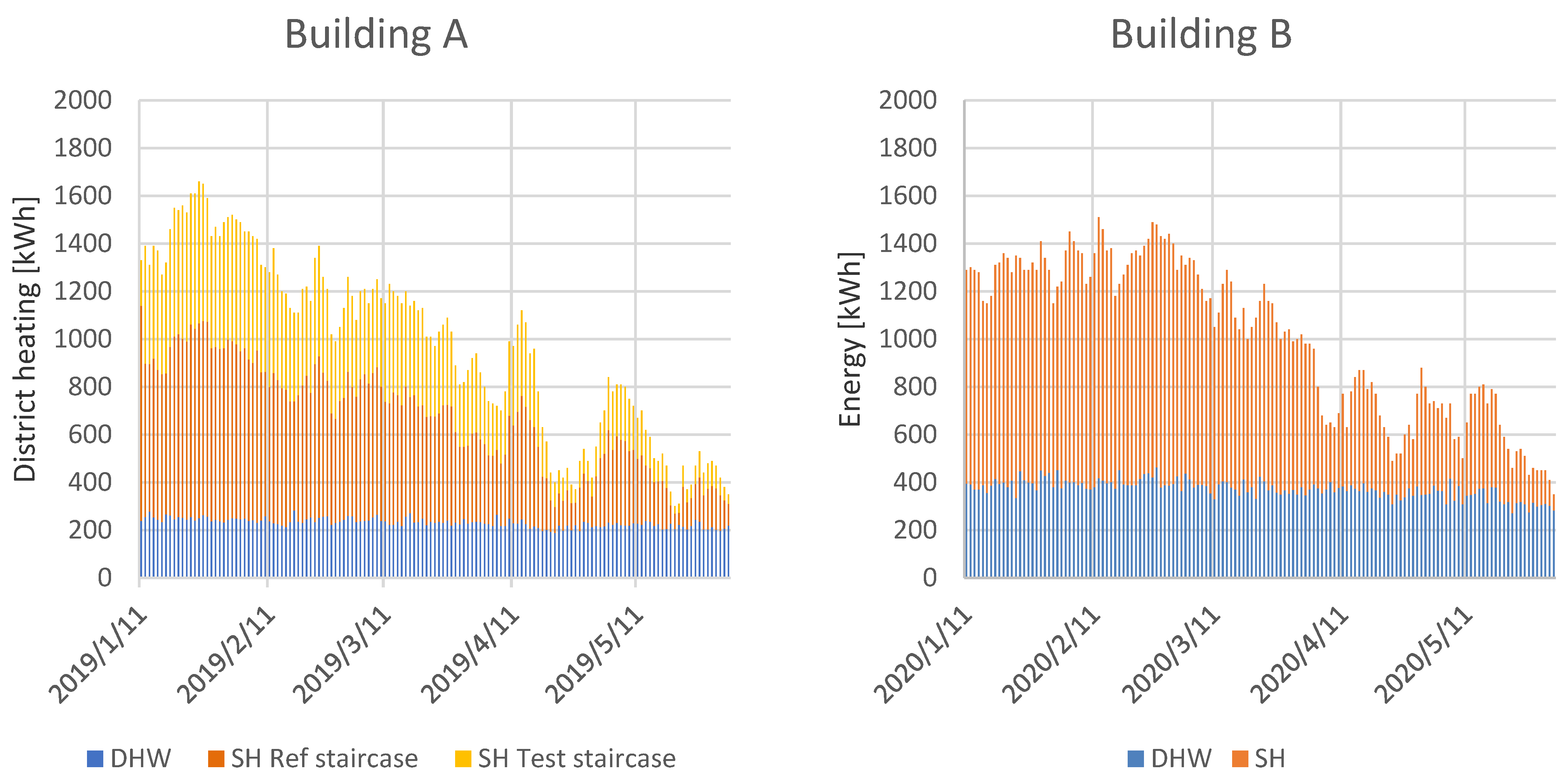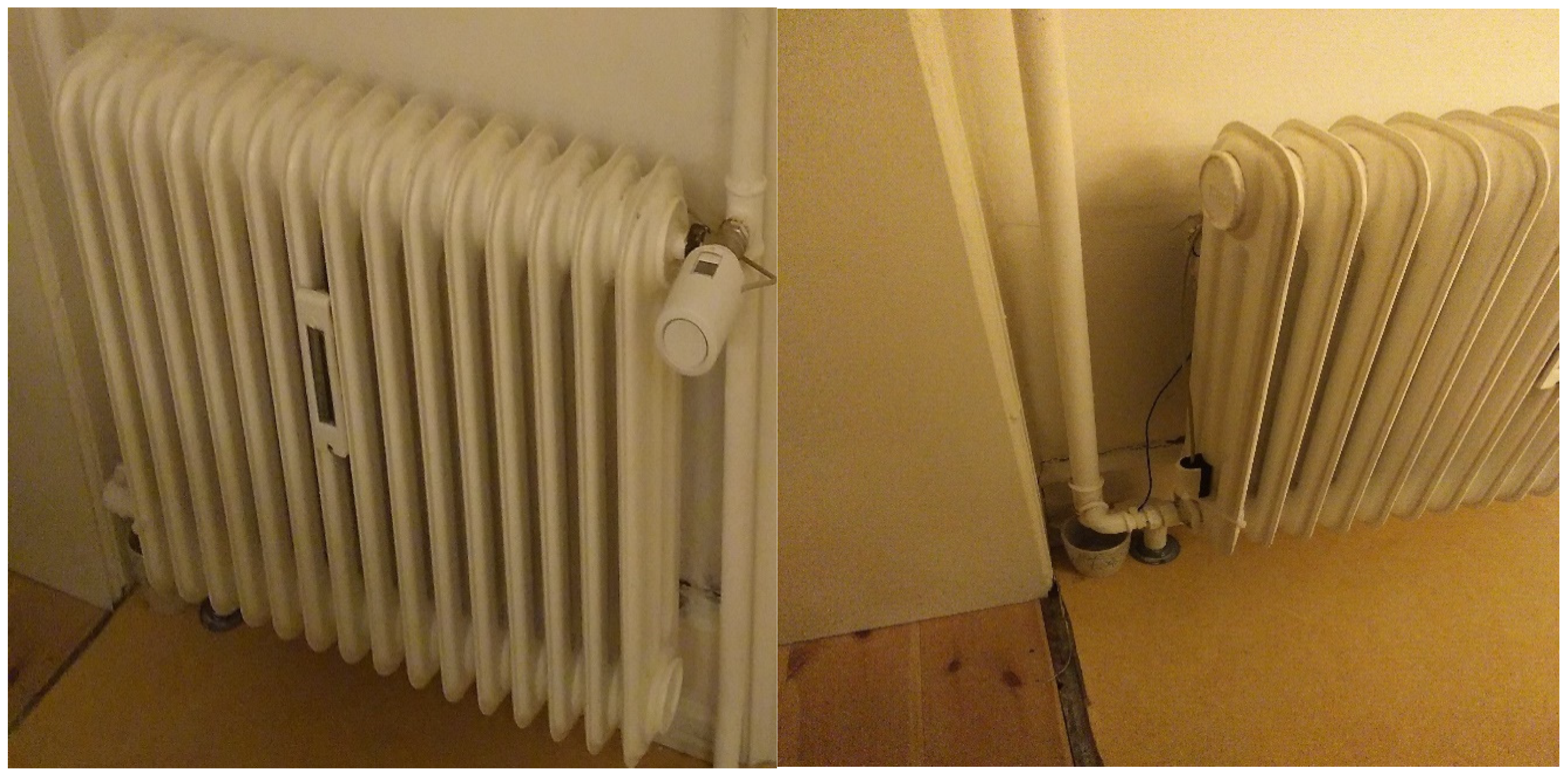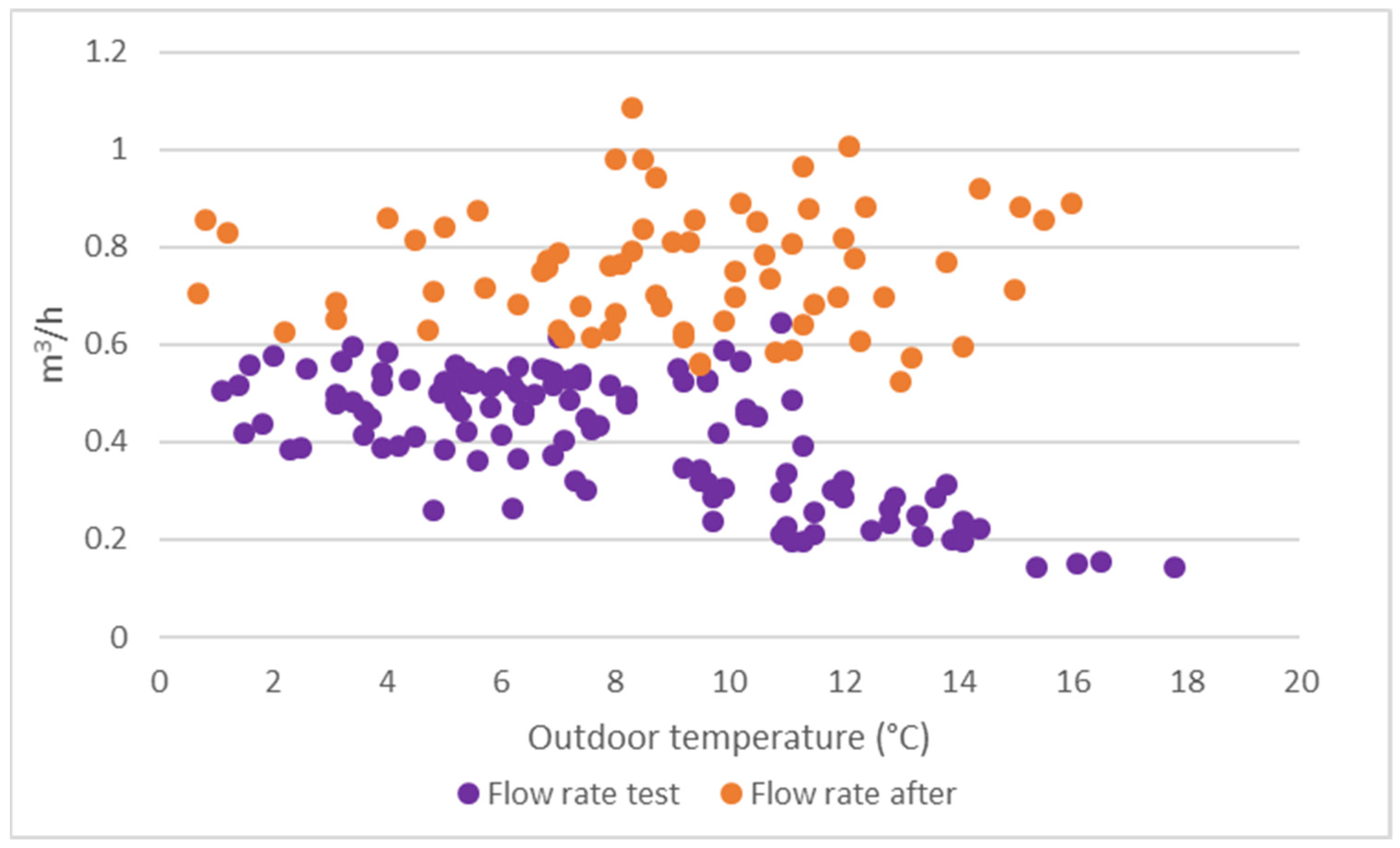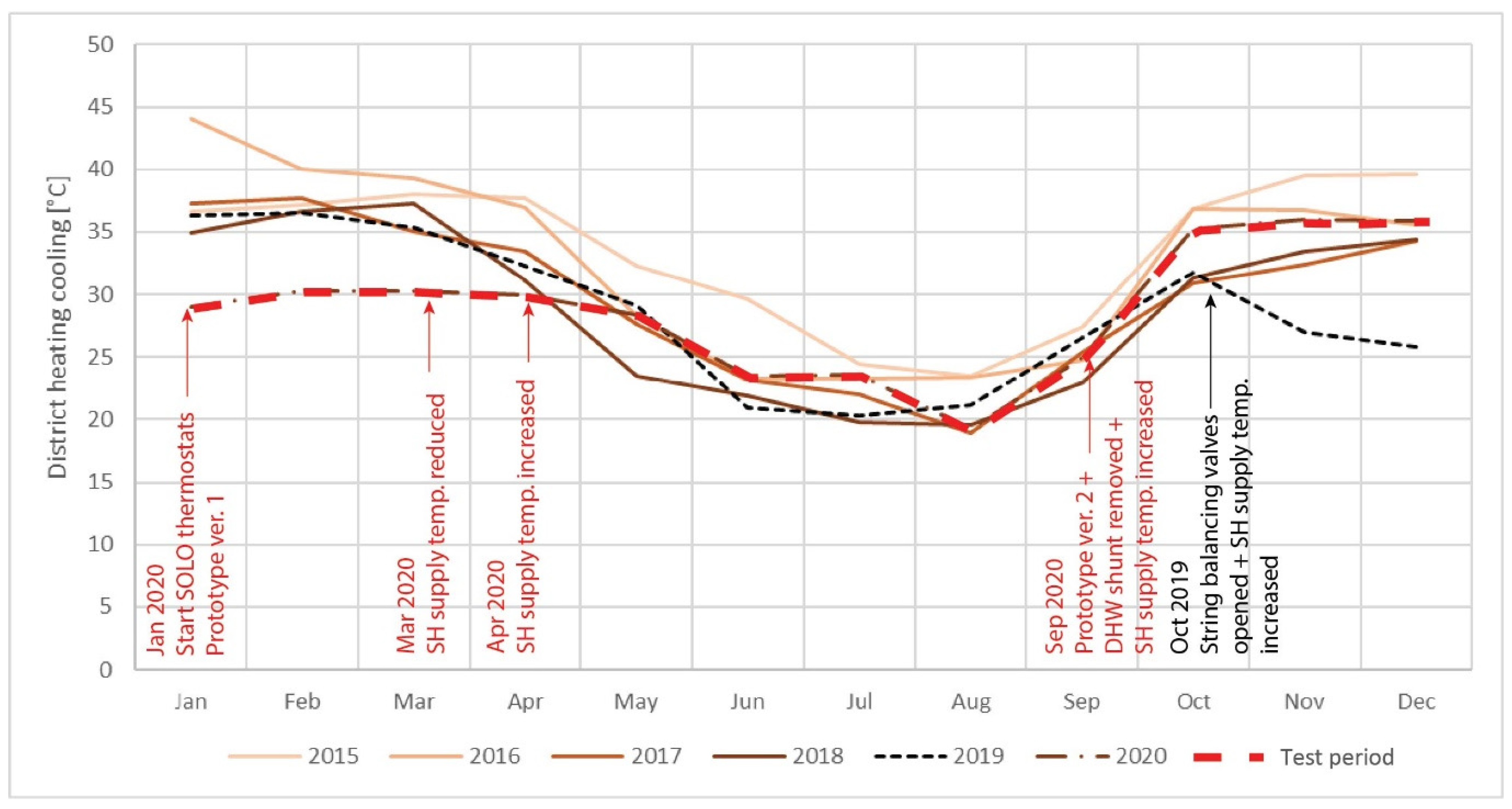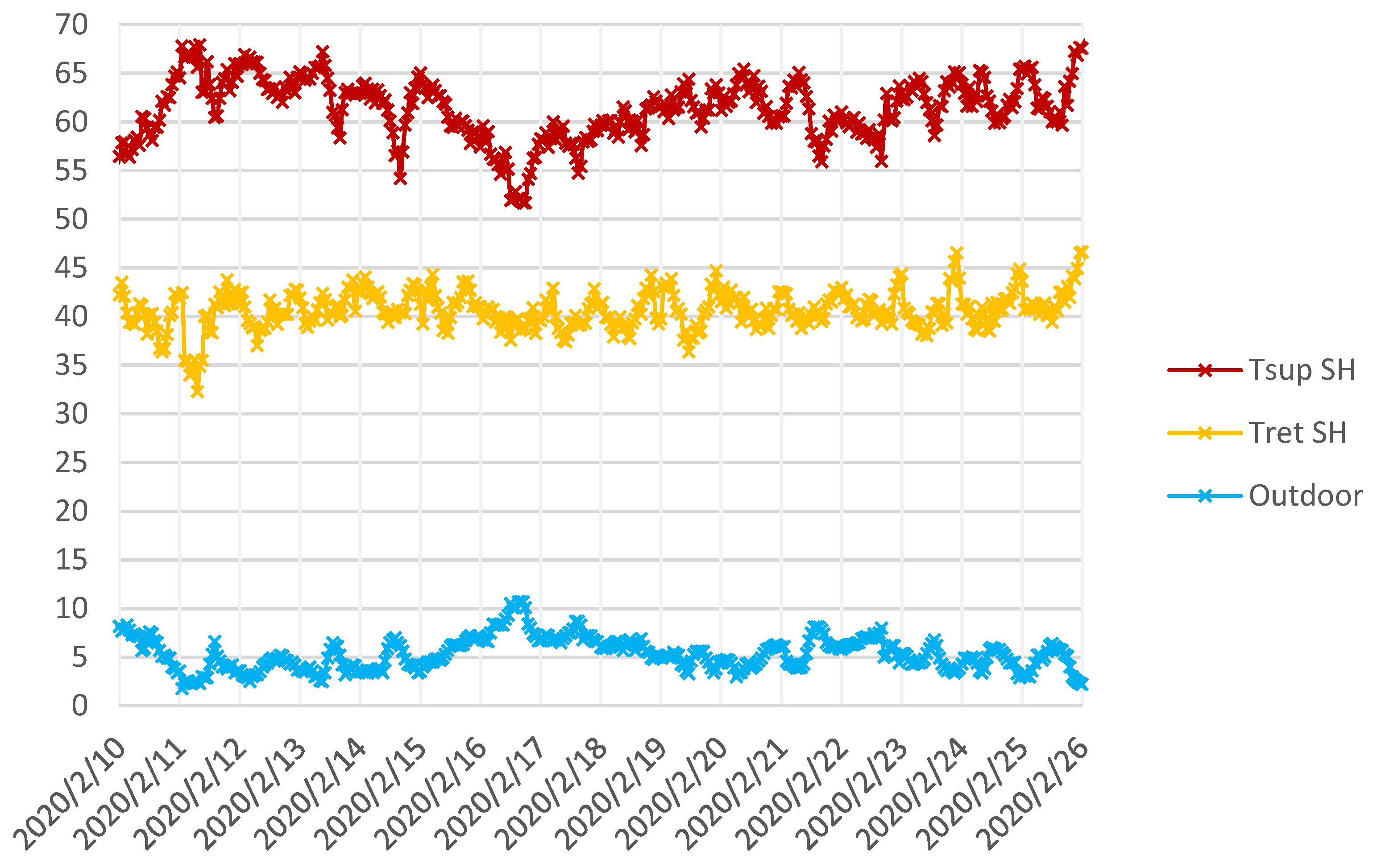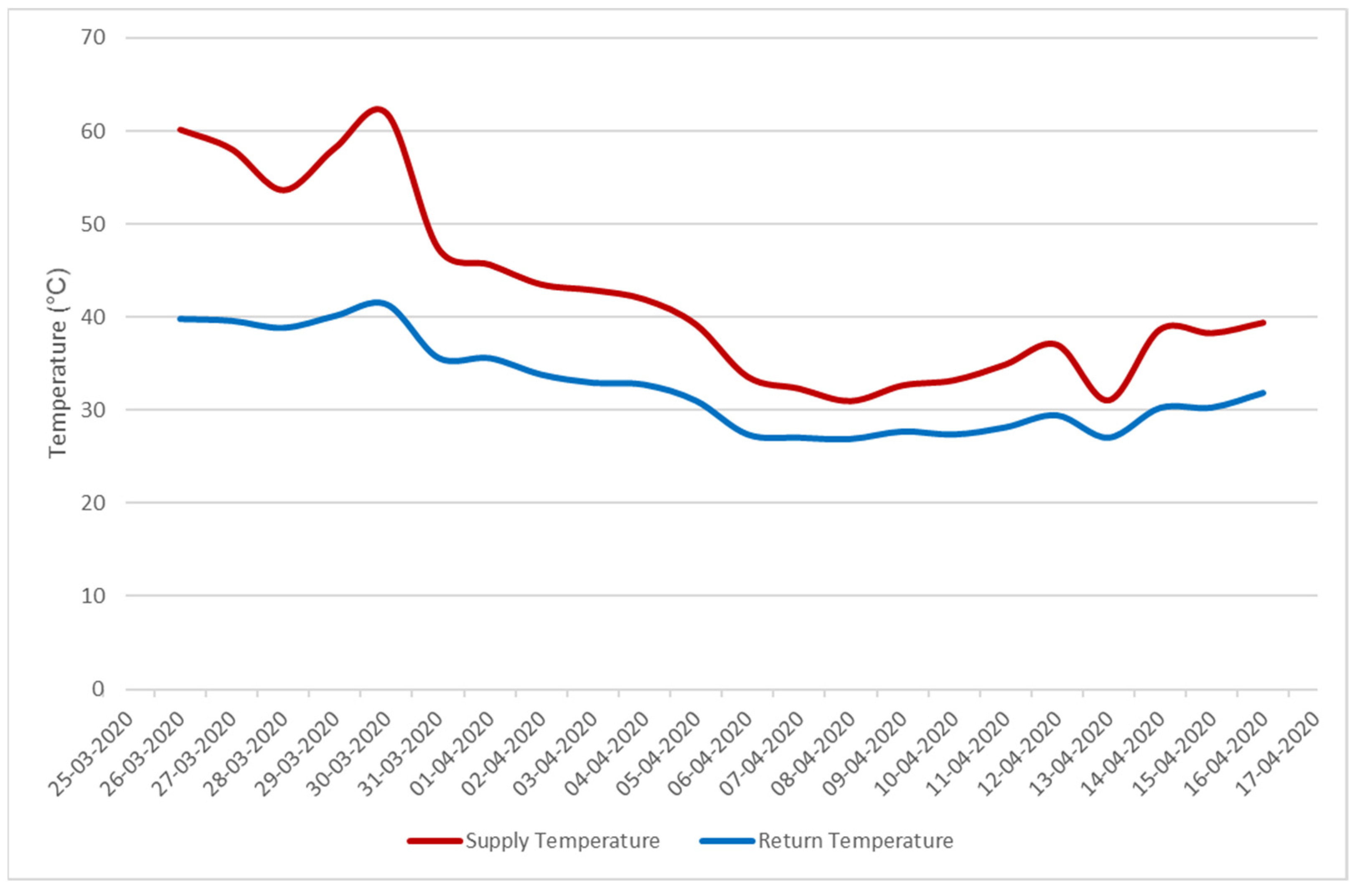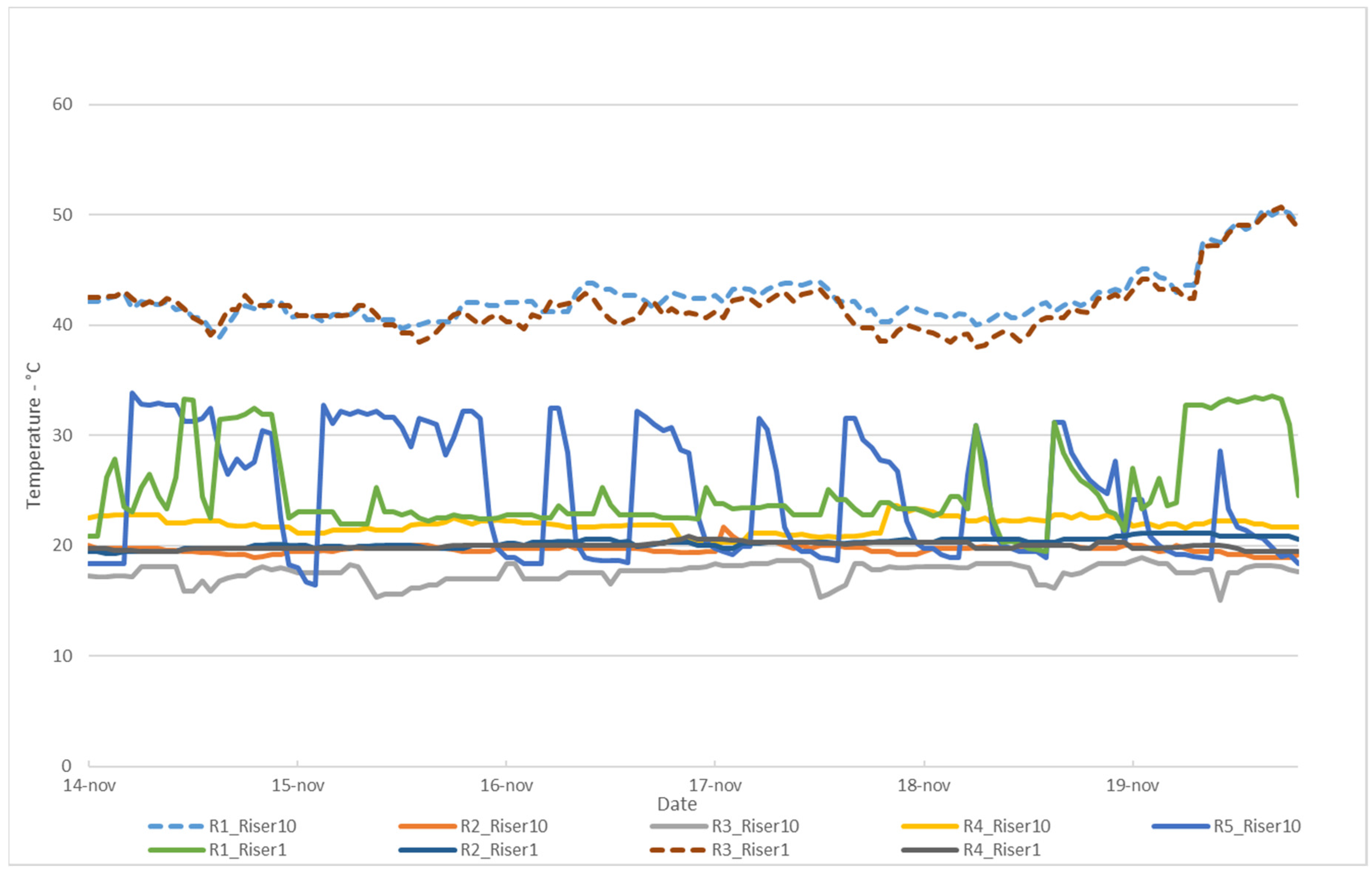1. Introduction
Heating and cooling in buildings account for almost half of the total final energy consumption in the EU [
1] and represent a strategic area to focus on for the ambitious EU targets of reducing CO
2 emissions and moving towards a sustainable energy system. The new EU strategy on the adaptation to climate changes is aiming to achieve a climate-resilient society by 2050 [
2].
District heating is among the key technologies that can sustain the green transition of the energy system due to its flexibility to integrate several energy sources. For district heating systems to provide the most economical transition to renewable energy sources, it is essential that the technology is continuously improved to reduce the operating temperatures and increase the efficiency of the systems [
3]. The district heating technological development aims to lower the operating temperature to an average of 55/25 °C, with the possibility of increasing the supply temperature if necessary during extreme low outdoor temperatures. This is defined in the literature as fourth-generation district heating (4GDH) [
4]. Lower operating temperatures will reduce the distribution heat losses in the networks, increase flue gases condensation and the power-to-heat ratio in combined heat and power (CHP) plants, increase the heat production from renewable sources—such as solar heating, geothermal heat, and excess industrial heat recovery—and the coefficient of performance of the heat pumps [
3,
4,
5].
However, the current supply and return temperatures in the heating installations in buildings supplied by the district heating system pose a limit to reducing the networks’ temperatures. If supply temperature requirements in buildings remain high, this limits the reduction of the networks’ temperatures and the use of renewable heat sources. Professionals design space heating systems based on extremely low outdoor temperatures and no heat gains to secure indoor comfort in the most severe conditions. These conditions rarely occur in normal heating system operations, so the heating elements are typically oversized, ensuring the possibility of implementing lower supply temperatures [
6,
7]. In addition, existing buildings undergo—or will have undergone—a certain amount of renovation over the years, further enhancing the ability to comfortability heat them with lower temperatures [
8,
9]. Some Danish case studies investigated the possibility of heating existing buildings with low supply temperatures for the most significant part of the heating season [
10,
11]. Similarly, in a Swedish survey, Jangster et al. [
12] showed that 109 existing buildings with radiators were comfortably heated with average supply and return temperatures of 64/42 °C at an outdoor temperature of −16 °C and that 55 °C or lower was sufficient for all radiators for outdoor temperatures equal or above 5 °C.
Rämä et al. [
13] illustrated that return temperatures in the range of 25–35 °C should be expected from well-controlled and -operated heating systems. The low-end range would be adequate for single-family houses, whereas return temperatures up to 35 °C should be obtained in multi-story buildings [
14]. Nonetheless, this is seldom the case, as in European district heating systems it is common to experience supply temperatures in the range of 75–90 °C and return temperatures of 40–50 °C [
15]. High return temperatures also have the effect of causing a small temperature difference between supply and return in the networks. This can be detrimental to the hydraulic capacity of the networks, forcing the district heating operators to maintain unnecessary high supply temperatures to deliver the heat demand, in particular during peak heat demand conditions [
16].
Among the main causes of such high operating temperatures in the networks is the accumulated effect of faults and poor control in the substations and heating systems. Gadd and Werner [
17] found that 74% of the surveyed substations were beset by certain errors and highlighted the importance of automation and data analysis to cost-effectively locate them. Another survey of over 246 Swedish district heating substations documented that faults with secondary side components and incorrect temperature set-points and regulation accounted for more than 60% of the total number of errors [
3]. Similarly, Månsson et al. [
18] showed that the most common issues were faults in the customers’ internal heating systems.
Radiators are the most used heating element in Europe, and they are typically controlled with thermostatic radiator valves. These passive control devices regulate the flow through the radiators according to the indoor temperature set-point selected by the end-users. The test of low supply temperature in five Danish single-family houses showed high return temperatures from the space heating systems in two of them due to a combination of poor flow control from the thermostatic radiator valves in some rooms and a few, too small radiators [
19]. By addressing those deficiencies, the heating system could be operated with a supply and return temperature of 55/30 °C. Ziang et al. the authors of [
20] found that 65% of thermostatic radiator valves, from a survey on 35 buildings in the UK, were performing poorly due to end-user misuse leading to thermal discomfort and higher energy consumption. Common examples of tenants’ inadequate control of local thermostatic radiator valves are on/off or proportional control. The former consists of keeping some radiators closed, leaving only a few of them to heat the entire flat; the latter is the wrong assumption that a higher thermostat setting would correspond to higher heat output [
21]. Both incorrect controls will inevitably lead to higher return temperatures. A simple solution is to couple a pre-set function with the thermostats to limit the maximum flow allowed through the radiators when the valve is fully open [
22].
In large space heating systems, further control is achieved by adding pressure-balancing valves to the vertical pipes—typically referred to as riser pipes or simply risers. The risers distribute the water flow from the basement to all radiators/flats in the building. The valves control the pressure change to secure a balanced hydronic system and a correct flow distribution in all building areas independently from the distance of the circulation pump. Averfalk and Werner [
23] listed seven essential improvements desirable for the fourth-generation district heating (4GDH) transformation. One key improvement concerns explicitly the possibility of achieving automated hydronic balancing in space heating systems in buildings to efficiently ensure the lowest possible district heating return temperatures. The shortcomings of the current manual hydronic balancing include that it is labor- and time-consuming. The balancing should be performed regularly to maintain optimal functionality continuously [
14]. However, it can be challenging to adjust the heating system accurately based on simplified calculations and manual work. At the same time, hydronic balancing is an important tool to secure the comfort of occupants while ensuring energy efficiency in the heating system operation with low heat consumption, low pump pressure, and low heating system supply and return temperatures [
24,
25,
26].
1.1. Novelty
The novelty presented in this article is the product development of a new smart electronic thermostat. Compared to the existing electronic thermostat design available in the market, this new one is equipped with an additional temperature sensor connected to the return side of each radiator and an algorithm to secure more accurate control of the opening or closing of the valve based on a maximum return temperature setting. The purpose of this functionality is two-fold. First, it should help ensure low return temperatures from the space heating systems by keeping them below the set point. This will help obtain a low district heating return temperature and be convenient for the occupant since it will ensure proper heating system operation even when windows are open or there are holiday setbacks. Second, due to the automatic flow-limiting effect of the return temperature control, the thermostat should help provide automatic hydronic balancing of the heating system. This new thermostat could thereby provide one combined solution for some of the essential issues in space heating systems in buildings connected to future low-temperature district heating systems.
1.2. Aim
The aim of this project was to develop a prototype of this new thermostat and perform field tests to document the potential improvements. Field tests were carried out in two different apartment buildings in Frederiksberg, Denmark. The goal was to demonstrate:
That the new thermostat can help limit the return temperature from the space heating system in apartment buildings and thus ensure a low district heating return temperature; and
That the new thermostat can serve to provide automated hydronic balancing in smaller apartment buildings, and thereby ensure that all occupants can maintain the preferred indoor air temperature without the necessity of string balancing valves.
This paper reports the findings from the new thermostat tests and discusses the potential improvements that can be obtained by applying this type of thermostat in buildings heated by district heating.
2. Methods and Case Studies
To test the functionality of the new thermostat in two apartment buildings, the prototypes were installed on all radiators in part of the buildings and measurements on the heating system operation before, during, and after the test were collected and analysed to document how the thermostats performed in terms of limiting the return temperature to the district heating substation and ensuring hydraulic balancing in the heating systems.
2.1. Case Buildings
The prototypes of the new thermostat were installed and tested on two different building sites in Frederiksberg, Denmark. The first test building (A) is an old classic apartment building from 1905. The building is owned by a private housing association and consists of 20 apartments split on two staircases and has a total heated dwelling area of approximately 2900 m
2. The second test building (B) is an apartment building from 1947. The building is owned by a municipal social housing company and consists of 40 apartments and has a total heated dwelling area of approximately 2600 m
2. The sites thereby represent two examples of typical apartment buildings with different apartment sizes and occupant demography. The buildings are seen in
Figure 1.
Both buildings are heated by district heating through central apartment substations that are located in a plant room in the basement. The district heating substations consist of separate heat exchangers for space heating and domestic hot water. In Building A, the space heating system is a traditional two-pipe radiator system. In some of the rooms in the apartments, the occupants have installed hydraulic floor heating systems that are connected to the same space heating distribution pipes. In Building B, the space heating system is a two-pipe reversed return system with radiators. The domestic hot water systems in both apartment buildings have domestic hot water circulation. In Building B, a mixing shunt was installed on the primary side of the domestic hot water heat exchanger, with the purpose of reducing the district heating temperature to reduce the risk of lime precipitation.
The domestic hot water consumption in the test buildings was measured to 220 kWh/day on average in Building A and 326 kWh/day in Building B. This means that domestic hot water stood for 25–28% of the district heating demand in Building A and 39–43% in Building B in the past five years. In Building A, the thermostats were only tested on the radiators in half of the building and the space heating consumption was measured specifically for this one half.
Figure 2 shows the measured energy consumption for space heating and domestic hot water in the buildings during the test periods from 11 January–2 June 2019 (Building A) and 11 January 2020–2 June 2020 (Building B). In Building A, 41% of the total space heating during this period was consumed in the apartments around the test staircase whereas the larger share of 59% was spent in the reference staircase. Measurements showed that these shares were similar for the reference period in the fall of 2020.
2.2. Measurements
The functionality of the thermostats was analyzed based on measurements conducted in the test buildings. The analyses were based on the following measurements and measurement equipment:
Main energy meter measuring the total primary district heating consumption and temperatures in the building substation;
Additional energy meter installed to measure flow and temperatures in the secondary space heating system;
Additional energy meter installed on the primary side of the domestic hot water installation.
The main energy meters in the buildings provide data on overall district heating supply and return temperatures from the district heating substation, primary side flow, and total consumption of district heating. These measurements are normally used for billing and are available for long time periods on a monthly basis, whereas for the test period hourly values were made available for a more detailed overview.
The additional energy meters were installed into the central piping of the secondary side of the space heating system and on the primary side of the domestic hot water heat exchanger in order to document performance in the space heating system.
The energy meter in the space heating system provided hourly measurements of supply and return temperatures, energy consumption, and mass flow rate. These measurements were analyzed to see if the prototype thermostats were able to limit the return temperatures as expected and to identify any variation in the operation of the space heating system during the test period. The additional energy meter was available during the test period. In Building A, where the test of the prototype was carried out in half of the building, the energy meter was located only for the pipes supplying heating to that part of the building.
The energy meter on the primary side of the domestic hot water heat exchanger provided hourly measurements of primary side supply and return temperatures to the domestic hot water system and heat consumption for domestic hot water. This made it possible to analyse the share of heating used for space heating in the buildings and the effect on the overall district heating return temperature when changes were made in the space heating system. In addition, it made it possible to verify that changes in the secondary side return temperature in the space heating system had the expected effect on the primary side return.
More temperature sensors were installed in the buildings’ risers and on the return pipe of each radiator to give a detailed overview of the heating systems’ operation. The outdoor temperatures were also collected during the test period. A schematic overview of the sensors’ locations on the return risers in both buildings is included in
Figure 3 and
Figure 4.
2.3. Thermostat Prototypes
The new thermostat prototypes were electronic and looked similar to other electronic thermostats already available in the market. The novelty of these new thermostats is that they are equipped with an additional temperature sensor—to be attached to the lower part of the radiator for the most accurate return temperature measurement—and an improved control algorithm able to limit the return temperature by controlling the thermostat opening based on feedback from the return temperature sensors. The return temperature set-point is derived from the supply temperature and a differential temperature over the radiator to emit the heat power within a suitable range. The set-point is determined based on:
The controller analyses the return temperature each minute and responds immediately to exceedances of the set-point limit by closing the valve until the return temperature is within the limit.
Figure 5 shows the pictures of one prototype thermostat and how it was mounted on the radiators in the test buildings.
Two different prototypes were developed and tested during the length of this project. The first one had only one return temperature control profile that controls this temperature according to the supply temperature and the part-load operation of the radiator. Instead, the second one was implemented with five new adjustable profiles. The improved version of the return temperature profiles was necessary to better take into account the differences in room/building heating losses and the possibility for the end-users to choose between a comfort and economy mode. A common feature kept in both prototypes is the adaptive dynamic control of the return temperature. This functionality prevents a rapid change in room temperature—i.e., due to the opening of a window—which would require more flow through the radiator, from a steady-state situation that will result in unnecessary high return temperatures. Additionally, in the second version, the prototype’s robustness was improved against end-user misuse of the controllers. Essentially, users cannot override the thermostat control curves by increasing the flow through the radiators once they set the thermostat to the expected indoor comfort level.
2.4. Test Periods
The test of the first thermostat prototype started in early 2019 in Building A. Shortly before the building was chosen for the test, it had been equipped with new string balancing valves (at the end of 2017), and a new district heating heat exchanger unit (May 2018). The first version of the prototype thermostats was installed on all radiators in half of the building from January 2019 to September 2019. This meant that all radiators in 10 apartments around one of the two staircases in the building were equipped with the new thermostats. During the test period, the space heating supply temperature was increased to test the return limiting functionality. In March 2019 a small test was also made where the string balancing valves in the heating system were opened up completely for a few days to test the balancing capabilities of the thermostats. In September 2019 after the thermostats were taken down, the occupants were offered new state-of-the-art thermostats as a replacement. Approximately two thirds of the occupants, therefore, had electronic thermostats, while the rest of the occupants chose to install mechanical radiator thermostats.
In Building B, the test of the first version prototype started in early 2020. In October 2019, before the beginning of the test, the string balancing valves in the space heating system were opened up completely to test the thermostats’ balancing functionality. The thermostats were installed on all radiators in the whole building in January 2020 and the test lasted until September 2020. During the test period, a small test was made to see how a reduction in the supply temperature affected the operation of the heating system. This was performed over a period of a couple of weeks in the beginning of April 2020. In September 2020, the first prototype thermostats were taken down and replaced with the second prototype version. The new test was carried out from September 2020 to December 2020. Similar to Building A, after the thermostats were taken down, the occupants were offered new state-of-the-art thermostats as a replacement; two thirds decided on electronic thermostats, the rest on mechanical ones.
5. Conclusions
New electronic thermostats were tested in two multi-family buildings in Denmark, both connected to the local district heating network. The results documented that this prototype thermostat can embed the functionalities of the traditional thermostatic radiator valve and the riser balancing valves in the same design. In particular, integrating an extra return temperature sensor ensured better flow control through the radiators and the lowest possible return temperature. In addition, installing these thermostats can allow the automatic hydronic control of the heating system, making the risers’ balancing valves redundant. It was found in Building A that the cooling of the district heating temperatures —defined as the difference between the supply and return temperature—was 4–12 °C higher in 2019 during the test compared to winter and spring 2020 when the prototypes were replaced with state-of-the-art thermostats.
The measurements also suggested that optimal operation in large buildings is sensitive to well-controlled heating systems. Only two uncontrolled radiators out of 175 were able to contaminate the overall return temperature in Building B. In one case, the reason was a manufacturing problem—which was an acceptable issue in the development of a new product—whereas, in the second one, it was due to the end-users tampering with the thermostat. This last aspect can be potentially critical for any space heating system control. The results highlighted two main elements. Firstly, the importance of remotely connected devices. The measurements from the thermostats helped pinpoint the faults in the heating system, although the end-users were not experiencing any discomfort. By also correcting the pump setting and closing the string balancing valves in the two risers to limit the flow to the uncontrolled radiators, it was possible to reduce the overall return temperature to 35 °C, neutralizing the negative effect of the malfunctioning thermostats. Hence, the digitalization of the demand side represents a critical element for the transition towards low-temperature operations and can support the activities of building service personnel, which are labor- and time-consuming because they have to be manually performed.
Secondly, the test in April 2020 suggested that the minimization of the supply temperature may be a promising strategy to mitigate the negative effect of uncontrolled radiators in the space heating systems without compromising indoor comfort in the apartments. This control strategy should be tested further and prioritized in space heating systems because, in addition to increasing robustness against the effect of uncontrolled radiators, low supply temperatures are important to exploit the potential of renewable sources, to recover waste heat, and increase the coefficient of performance of heat pumps in future low-temperature district heating networks.
Lastly, the key finding for future product development is to secure the most robust design that could minimize the negative impact of end-user misuse of local controllers in heating elements. An improved design may integrate a new safety functionality that closes the valve or limits the flow to a minimum in case of damage to thermostats or incorrect signals from the sensors. This would not be detrimental for the indoor comfort in flats and would avoid a few radiators compromising the low-temperature operation of an entire building.
